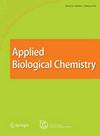Insecticidal effects of Tabebuia avellanedae-derived Constituent and its analogues against Nilaparvata lugens and Laodelphax striatellus
Journal of the Korean Society for Applied Biological Chemistry
Pub Date : 2011-10-01
DOI:10.3839/JKSABC.2011.126
引用次数: 4
Abstract
Insecticidal activities of an active constituent derived from the bark of Tabebuia avellanedae and its analogues were examined using a micro-topical application bioassay against the brown planthopper, Nilaparvata lugens and the small brown planthopper, Laodelphax striatellus. The active constituent of T. avellanedae bark was characterized by various chromatographic methods and identified as 2-Hydroxy-3-(3-methyl-2-butenyl)-1,4-naphtoquinone. On the basis of 48 h lethal concentration 50 (LD50) values, the most toxic compound against N. lugens was 1,4-Naphtoquinone (0.042 μg/female), followed by 5,8-Dihydroxy-1,4-naphtoquinone (0.080 μg/female), 2-Hydroxy-3-(3-methyl-2-butenyl)-1,4-naphtoquinone (0.091 μg/female), and 2,3-Dichloro-1,4-naphtoquinone (0.186 μg/female). Similar results against L. striatellus were observed for 2-Hydroxy-3-(3-methyl-2-butenyl)-1,4-naphtoquinone and its analogues, except for 2,3-Dichloro-1,4-naphtoquinone and 5,8-Dihydroxy-1,4-naphtoquinone. These results indicate that T. avellanedae bark-derived material and its analogues have potential as new preventive agents for control of N. lugens and L. striatellus.黄花参衍生成分及其类似物对褐飞虱和纹状老年虫的杀虫效果
采用微量外用生物测定法研究了从桔梗树皮及其类似物中提取的活性成分对褐飞虱褐飞虱和褐飞虱褐飞虱褐飞虱的杀虫活性。采用多种色谱方法对黄皮的有效成分进行了表征,鉴定为2-羟基-3-(3-甲基-2-丁烯基)-1,4-萘醌。根据48 h致死浓度50 (LD50)值,对褐家蝇毒性最大的化合物为1,4-萘醌(0.042 μg/雌),其次为5,8-二羟基-1,4-萘醌(0.080 μg/雌)、2-羟基-3-(3-甲基-2-丁烯基)-1,4-萘醌(0.091 μg/雌)和2,3-二氯-1,4-萘醌(0.186 μg/雌)。除2,3-二氯-1,4-萘醌和5,8-二羟基-1,4-萘醌外,2-羟基-3-(3-甲基-2-丁烯基)-1,4-萘醌及其类似物对纹状乳杆菌的抑制效果相似。上述结果表明,桔梗树皮衍生材料及其类似物具有作为防治褐飞虱和纹状体白僵菌的新药剂的潜力。
本文章由计算机程序翻译,如有差异,请以英文原文为准。
求助全文
约1分钟内获得全文
求助全文
来源期刊

Journal of the Korean Society for Applied Biological Chemistry
FOOD SCIENCE & TECHNOLOGY-FOOD SCIENCE & TECHNOLOGY
自引率
0.00%
发文量
0
审稿时长
4-8 weeks
 求助内容:
求助内容: 应助结果提醒方式:
应助结果提醒方式:


